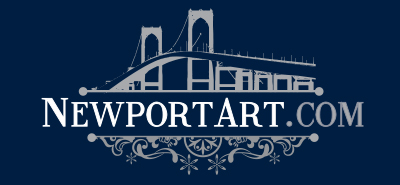
Impressionist painter Willard Leroy Metcalf was born July 1, 1858 in Lowell, MA the son of Greenleaf Willard, a violinist with the Boston Orchestra and Margaret Jan Gallop. In 1863, the Metcalfs moved to a farm in Maine and in 1871 moved to Cambridgeport, MA, where Metcalf attended school. Metcalf’s parents participated in the occult and predicted their son would become a painter and encouraged him in that direction.
Metcalf attended the Mass. Normal Art School (Boston), apprenticed as a wood engraver (1874) and studied with George Loring Brown (who taught him to draw accurately truths in nature, and to paint Roman figures, judges and wreathed heads with the same precision) in South Boston and with Munich-trained Ignaz Gaugengigl at the Lowell Institute. The next year he entered the Museum School (Boston) and studied the Dutch tradition of painting with Otto Grundmann. He became the 1st scholarship recipient of the Museum School (1878) and struggled to survive by painting illustrations for Harper’s (1882).
That same year, Century magazine commissioned him to travel with Frank Cushing of the Smithsonian Institution and Boston newsman Sylvester Baxter to draw and paint Zuni Indians in Arizona and New Mexico, but the heat nearly killed Metcalf and he rapidly returned to Boston to exhibited seventy–five paintings with Chase Gallery. Because of the show’s success he traveled to England and joined Edmund C. Tarbell and Frank W. Benson in Paris.
Metcalf studied with Jules-Joseph Boulanger and Gustave-Rodolphe Lefebvre at the Académie Julian and painted in Pont Aven, Brittany, Grez-sur-Laing, Dieppe and in Giverny with Monet (1885-1886). In the fall of 1887 he painted in Tunis, Algeria and Morocco and returned that year to the U.S. to share a Tenth Street studio in NYC with impressionist painter Robert Reid, and a summer studio in Old Lyme (CT) with William H. Howe. He illustrated for Scribner’s, taught at the Arts Student League (1898-1908) and joined the Ten American Painters (1898).
In 1899, he painted in Gloucester with Charles A. Winter and J.H. Twachtman and in 1901 married his model Marguerite Beaufort Haile (an aspiring actress from New Orleans). When his wife ran off with painter Robert Nisbet (1902), Metcalf became an alcoholic and when Twachtman died that same year he became depressed and ill. In 1903, after he moved to Clark’s Cove (ME), stopped drinking and began to lighten his palette and paint with a looser brush, Metcalf confessed this period was his “new-birth,” or “Renaissance.”
In 1904, he returned to NYC with twenty-one magnificent landscapes that showed the changing atmospheric environs of nature. From 1909-1925 he studied nature’s tonal nuances as he painted snowscapes at Cornish, NH and he received rave reviews from critics and finally felt at peace.
Although he married Henriette Alice McCrea in 1911 and the couple had two children, McCrea would not play second fiddle to Metcalf’s art and drinking and she divorced him in 1921.
Metcalf continued to paint muted colors in delicate tapestries that explored the American landscape and the New York Herald (March 21, 1920) noted that in the study of winter he had “achieved his special metier.” Metcalf died in New York City March 9, 1925 a respected landscape impressionist who is represented in museums throughout America.
Awards: Paris Salon, hon. mention (1888); PAFA (gold, 1907, 1912); Columbian Expo., Chicago, 1893 (medal); SAA 1896 (medal); St. Louis Expo. (medal, 1904); Corcoran Gallery (gold medal, 1907); Art Institute of Chicago (silver medal, 1910); Buenos Aires Expo, (gold medal, 1910)
Solo Exhibitions include: St. Botolph Club (1889); Adler & Schwartz Gallery, NYC (1905); Corcoran Gallery (1925); Montross Gallery (1910, NYC);Newport AA (inaugural, 1912); Milch Galleries, NCY (Memorial, 1925); Spanierman Gallery, Retrospective (1996); Hood Museum of Art, Dartmouth College (1999).
Bibliography: Richard Boyle & E. DeVeer, Sunlight & Shadow: The Life and Art of Willard Metcalf (Abbeville, NY, 1988); Patricia Jobe Pierce, The Ten (1976).
Patricia Jobe Pierce, historian
